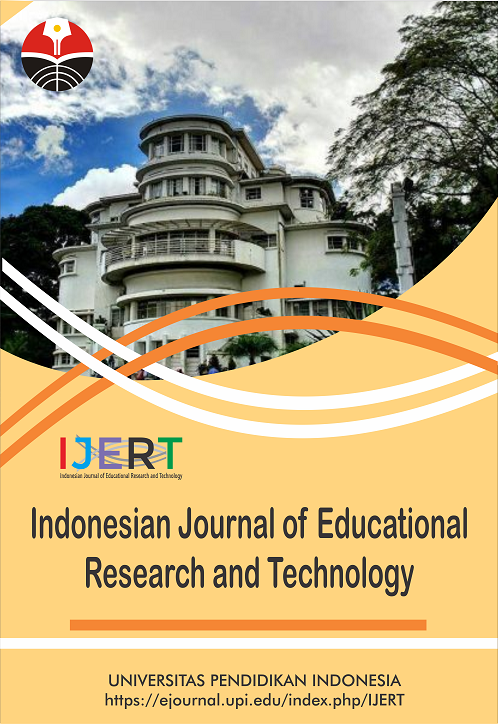Teaching and Learning with Technology: Effectiveness of ICT Integration in Schools
Abstract
Keywords
Full Text:
PDFReferences
Abdullah, M. S., Toycan, M., and Anwar, K. (2017). The cost readiness of implementing e-learning. Custos E Agronegocio On Line, 13(2), 156-175.
Albirini, A. (2006). Teachers’ attitudes toward information and communication technologies: The case of Syrian EFL teachers. Computers and Education, 47(4), 373-398.
Arukaroon, B., and Krairit, D. (2017). Impact of ICT usage in primary-school students' learning in The Case of Thailand. International Journal of Web-Based Learning and Teaching Technologies (IJWLTT), 12(2), 21-42.
Baldwin, R. G. (2009). The climate for undergraduate teaching and learning in STEM fields. New Directions for Teaching and learning, 2009(117), 9-17.
Ghavifekr, S., and Rosdy, W. A. W. (2015). Teaching and learning with technology: Effectiveness of ICT integration in schools. International Journal of Research in Education and Science, 1(2), 175-191.
Ghavifekr, S., Razak, A. Z. A., Ghani, M. F. A., Ran, N. Y., Meixi, Y., and Tengyue, Z. (2014). ICT integration in education: Incorporation for teaching and learning improvement. Malaysian Online Journal of Educational Technology, 2(2), 24-45.
Hashim, S., Masek, A., Abdullah, N. S., Paimin, A. N., and Muda, W. H. N. W. (2020). Students’ intention to share information via social media: A case study of COVID-19 pandemic. Indonesian Journal of Science and Technology, 5(2), 236-245.
Karniawati, N., Simamora, R., and Zain, B. T. (2021). Information Communication and Technology for Political Communication Ethics. International Journal of Computer in Law and Political Science, 1, 21-26.
Liu, L. G., and Gee, H. (2017). Determining whether commercial publishers overcharge libraries for scholarly journals in the fields of science, technology, and medicine, with a semilogarithmic econometric model. The Library Quarterly, 87(2), 150-172.
Puspitawati, L., Nurhasanah, A., and Khaerunnisa, A. (2021). Utilization of Communication Technology for Business. International Journal of Informatics, Information System and Computer Engineering (INJIISCOM), 2(1), 47-54.
Rachmawati, R. (2019). Utilization and Quality of Information System for Administration Services Based on ICT In Patehan, Kraton, Yogyakarta. Indonesian Journal of Science and Technology, 4(1), 55-63.
Riyanto, Y., Nandiyanto, A. B. D., and Muhammad, N. (2021). The effectiveness of distance teaching and learning activities in primary schools. Indonesian Journal of Multidiciplinary Research, 1(1), 1-6.
Saripudin, S., Rohendi, D., and Abdullah, A. G. (2020). Developing information technology in opencourseware: From movements to opportunities in Asia. Indonesian Journal of Science and Technology, 5(3), 308-320.
Sarker, M. N. I., Wu, M., Cao, Q., Alam, G. M., and Li, D. (2019). Leveraging digital technology for better learning and education: A systematic literature review. International Journal of Information and Education Technology, 9(7), 453-461.
Sumitra, I. D., Wirawan, E., Putra, M., Kusumaningrat, I., and Maulana, H. (2021). Design of webinar information system for people with hearing impairments. Indonesian Journal of Community and Special Needs Education, 1(2), 77-86.
Wang, Q. (2008). A generic model for guiding the integration of ICT into teaching and learning. Innovations in education and teaching international, 45(4), 411-419.
DOI: https://doi.org/10.17509/ijert.v2i2.43554
Refbacks
- There are currently no refbacks.
Copyright (c) 2022 Universitas Pendidikan Indonesia

This work is licensed under a Creative Commons Attribution-ShareAlike 4.0 International License.







.png)




